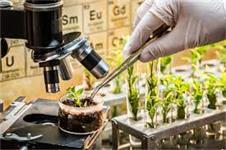Text A Crop breeding and improvement
Plant breeding is the science of changing and improving the heredity of plants.
In the past the breeders had no scientific knowledge which is available now. The selection of superior types was the most important method of improving crop plants. Variations between plants of the same species were used as the basis for developing new improved varieties.
Now with increased knowledge of genetics and related plant sciences plant breeders are able to influence such plant characteristics as yield, early maturity, drought resistance, winter hardiness, disease resistance, insect resistance and quality.

Plant breeding depends on many sciences, genetics and cytogenetics being the two most important. Other sciences needed by the breeders are plant physiology, plant pathology, entomology, plant biochemistry, agronomy, botany, statistics and computer science. The most successful achievements in plant breeding are due to the combined work of many specialists.
Each crop variety possessing certain desirable and undesirable characteristics, the aim of the plant breeder is the development of a superior variety by eliminating the undesirable qualities and combining the desirable ones in the same variety.
The characteristics desired vary with1 the crop and the conditions of growing. With wheat, for example, winter hardiness, protein content, milling quality and resistance to lodging are important. In some areas, early-maturing, cold-resistant varieties are needed, while in others later-maturing, drought-resistant varieties will do best, yield and resistance to major diseases and insects being important in all cases.
Three general methods of crop improvement are commonly used. These are introduction, selection and hybridization, the last one being the method of crossing two or more varieties that differ in some inherited characters. These methods are not wholly distinct because hybridization almost always must be preceded or followed or both preceded and followed by some scheme of selection.
Progress in crop breeding can be measured only by experimental tests except when breeding is done for disease resistance, better colour or some other character that can be readily seen. Even then the investigator must know how the new strain compares in yield with the variety replaced. That is why field-plot test2 should be conducted.
Notes to the text
1. to vary with – различаться в зависимости от; зависеть от;
2. field-plot tests – испытания на делянках в поле.
Grammar and Vocabulary Activities
5. Group the words according to the parts of speech (noun, pronoun, verb, participle I, participle II, proverb).
gradually, abundant, aggregated, lower, competition, properly additional, seeder, to decrease, poorer, directly, desirable, careful, limiting, suitable, requirement, removed, maintenance, wider, mixture, mechanical, physiologist, harrowed, favouring, fixer, to destroy, finest, follower.
6. Higilight the Absolute Participial Construction in the following sentences. Translate these sentences.
1. Plant breeding being the science of changing the heredity of plants, the scientists widely use it in improving crop plants.
2. Many plant sciences are used by plant breeders in developing new varieties of crops, genetics and cytogenetics being most important.
3. Many varieties of corn producing good yields of high quality forage and grain are cultivated throughout our country.
4. Each plant has two parts, the roots and the above-ground portion, the latter consisting of leaves and stems.
5. The stem of corn varies greatly in length in different varieties, the usual length being 5 to 10 feet.
6. Planting machines being used, a smaller amount of seed is required.








